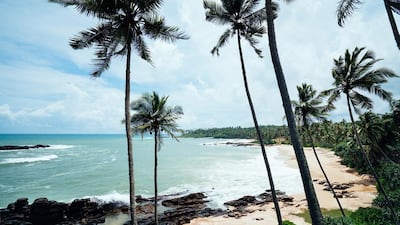Why Tangalle?
After more than a decade of rebuilding in the wake of the 2004 tsunami, this backpackers’ beach haven on the south-east coast of Sri Lanka – pronounced Tan-GAH-leh – is kicking it up a notch, with the arrival of big-name luxury beach resorts to its seductive, palm-tree-lined shores. So at this moment it’s an ideal mix of polished and rough: you can stay in the luxury surrounds of a familiar hotel chain while venturing out to discover the charm of rural fishing villages and fields of rice paddies, interspersed with Buddhist temples encircled by elephant-head fences. It’s also a suitable base for combining a beach holiday with a visit to Udawalewe National Park, Sinharaja Forest Reserve or the Handunugoda Tea Estate.
A comfortable bed
The newest luxury choice is Anantara Peace Haven Tangalle Resort (www.anantara.tangalle.com; Dh1,048 a night including taxes and breakfast), on the grounds of a former copra plantation that overlooks its own beach on the Indian Ocean. Among the many activities it offers, such as mask carving and a nightly sundown ceremony, the amusing staff can arrange cultural visits, including shopping for ingredients at the local market that you then use to make a Sri Lankan meal. Around the corner, the Amanwella (www.aman.com) has just been refurbished; rooms cost from $812 (Dh2,980) per night including taxes.
Budget options include staying on stilts at Palm Paradise Cabanas (www.beach.lk; a cabana costs $105 [Dh386] a night including breakfast, dinner and taxes), located in a palm grove near Tangalle Beach, or Saman Homestay, which is a short walk to Medaketiya Beach and has scooters for rent (No 6 Medaketiya Road, Dh55 including taxes). Somewhere between the many budget guest lodges and the high-end resorts, it's worth checking out two unique boutique hotels: The Last House, designed by Geoffrey Bawa (www.thelasthouse.com; rooms start at about $165 [Dh606] a night), and Maya, a stylishly remodelled 19th-century manor house (mayatangallesrilanka.com; about $190 [Dh698] a night).
Find your feet
On the southern tip of Sri Lanka, Tangalle is less visited than the most popular resort areas. If you take a seaplane from Colombo, you’ll land at what might be the world’s most picturesque airport in Dickwella, just a shack near a dock on Mawella Lagoon, about 15 minutes from Tangalle. The 40-minute plane ride will spare you the 3.5-hour drive and provides a mesmerising bird’s eye view of Sri Lanka. The town of Tangalle, jammed with mobile-phone shops and tuk-tuk traffic, is a good pit stop for daytrips. To the west, there’s whalewatching in Mirissa (a 1.5-hour drive) and the historic fortress city of Galle (another hour past Mirissa). About half an hour to the north, explore the painted caves of the Mulkirirgala Rock Temple. To the east, nature lovers will be drawn to turtle-watching in Rekawa, the Kalametiya Bird Sanctuary and wildlife tours of Yala National Park.
Meet the locals
You can’t get more local than Tangalle’s Fishing Harbour, where you’ll find fishermen unloading the catch of the day from their colourfully painted boats. They’ll charge you 100 rupees (Dh2) for entry, but they’ll also let you climb on board their boats for a photo. Also worth exploring is the Vegetable Market on Ennapitya Road, near the bus station, a collection of covered food stalls with exotic fruits and spices.
Book a table
For a night out, Il Mare at Anantara’s resort serves freshly caught seafood and some superb pasta (try the gorgonzola gnocchi) along with a stunning sunset view from its clifftop terrace. For budget dining with a view of Medaketiya Beach, try the open-air Gayana, where you can have fish Sri Lankan-style with rice and coconut salad (1,100 rupees [Dh26]) followed by Sri Lankan coffee served in a teapot (440 rupees [Dh11]). Maya boutique hotel serves a set menu featuring Sri Lankan fusion, but you’ll have to arrange ahead of time if you’re not a guest (mayatangalle@gmail.com); it’s worth it just to relax on the shaded terrace overlooking the paddy fields.
Shopper’s paradise
There isn’t much high-end shopping in Tangalle, but the Anantara resort hosts a selection of some of Sri Lanka’s best-known brands, including the jeweller Sifani (a must for Sri Lankan sapphires) and the surprisingly good-value Barefoot, for brightly coloured textiles, soft toys and bags handmade by local artisans. For local souvenirs, visit Sanu Craft on Mattar Road. It has a wide selection of local crafts, such as wooden masks and leather bags, some of which are made in the on-site workshop.
Don’t miss
Watching the sun set from Tangalle’s idyllic beaches, framed by towering palm trees, isn’t just a blissful way to end the day; it also makes for great Instagramming.
What to avoid
Driving. The narrow streets are clogged with choppy and slow-moving traffic, so while you may feel the urge to venture out on a daytrip, allow extra time.
Getting there
Etihad (www.etihad.com) and Emirates (www.emirates.com) fly direct from the UAE to Colombo from Dh1,300 return, including taxes. A Cinnamon Air seaplane from Colombo's Bandaranaike International Airport to Dickwella costs $520 (Dh1,900) return, including taxes.
mgannon@thenational.ae

